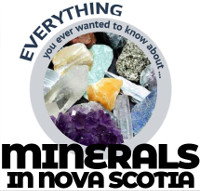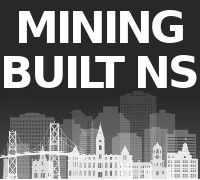- Why Mining Matters
- Jobs
- Safety
- Environment & Operations
- FAQ
- Links
- Fun Stuff
You are here

Thomas J. Brown
BESCO’s Pension
Dan McIsaac and Jim Taylor
Tius Tutty
Wilson Beaton
Aerotech Connector
Henry Swift
1885 Vale Tour
Douglas Slope Explosion
John Angus MacNeil and WWI
Florence Colliery
Joseph Walton
James Lennon
James Hamilton
1918 Allan Mine Disaster
Robert Boutilier’s Luck
Springhill’s John Anderson
Plight of Youth in 1931
Miners’ Wives Praised
Dominion No. 1B in 1931
Allan Shaft, 1931
Private Maceachern
Husseys Prospectus
William Routledge
Swell Factor in Reclamation
Gowrie Mine
River Hebert
Joggins 1904 Fire
Port Hood 1911 Flood
Lamp Cabin Memorial Park
Drummond 1873 Disaster
1872 Accidents
Springhill’s Novaco Mine
1860's Accident
New Glasgow's Linacy Mine
1913 Drummond Fires
1908 Princess Fire
Albion Mines 1913 Fire
DOSCO Miner
Cape Breton's TNT
The McCormick and Turner families
Payday Drunk
John Croak’s Victoria Cross
Atlantic Slag Company
Sydney Cement Company
1914 Coal Mine Cost
Dominion No 2
Canary in a Coal Mine
Draegermen
James Dinn
Pit Ponies
Henry Wadsworth Longfellow
1877 Accidents
Allan Shaft 1912
William Fleming
The Story of Peat
T. G. MacKenzie
Trenton Steel
1930 Stats
MacGregor Mine Explosion
MacGregor Flood
Torbanite Products Limited
Abraham Gesner and Kerosene
1860 Prince of Wales Visit
Dominion No 5
The Royal William and Stellarton Coal
Tom Pit
Terminal City
1875 Accidents
Cannons in Coal Mines
Princess Mine Explosion
Dominion No. 26
A Tale of Two Mines
Franklin Colliery
Robert J. Grant
Springhill No. 1
Mother Coo
Submarine Mines
Barrachois Mine
Fundy Coal Seam
Dominion #14
Dominion #12
Dominion No 4
Child Labour
Joggins Colliery
Safety
Bootleggers
Richmond County
Mabou Mines
Stellar Coal
English Slope
Maccan/Jubilee
The Foster Pit Fire and the Poop Solution
Thomas Edison and the Chignecto coal mine
Henry Whitney and the Dominion Coal Company
Foord Pit
Hiawatha Coal Mine
Coalburn
Springhill Disasters
St. Rose-Chimney Coalfield
Stellarton, Dorrington Softball Complex
How Does Coal Form?
Drummond Coal Mine
Sydney Coalfield and the Princess Mine
Port Morien, 1720
Port Hood
General Mining Association
Thorburn
WWII and Nova Scotia Coal
Nova Scotia's First Railway
Samuel Cunard
Stellarton’s Mining Connections
Sydney Mines
Point Aconi
Victoria Mines
Sullivan Creek
New Campbellton
Inverness and Cabot Links
The Ghost Town of Broughton
Tobin Road, Sydney Mines
Flint Island Coal Mine?!
What does Colliery mean?
Cottam Settlement
Allan Mine

Aerotech Connector
Rock In Gum
Crusher Dust
Rock ID
Muskrat Falls Hydro
Blind Ben Morris
Highway 107
Loops and the Cornish Miner
Birchtown’s Black Granite
Cliff Safety
Lake Enon Celestite
Pumice and Stone-Washed Jeans
WWII Exploration
Gibraltar Black Granite
Seal Island Bridge
Fort Needham
Wilmot Spa Springs
Opal
Kiwanis Park
Three Types of Rock at Peggy's Cove
Guysborough’s Alumina
Inside Asphalt
The Concrete House
Canso Causeway
Shubie Park
Sambro Lighthouse
Titanic Headstones
Why are some roads red?
Marshdale Gabbro
New Britain Quartz Mine
Mica Hill
King Quarry
Queensport
Quarry Lake
Miners in War
The Pit
Oxford Tripoli Company
Sibley Mountain Slate Quarry
Terence Bay
East Gore Slate Quarry
Governor Lake Pegmatite
Spryfield Quarries
The Hydrostones
Bricks and the Halifax Explosion
Armdale Roundabout
South River Lake Quarry
Shelburne Granite Boulders
Belmont Pit
Whetstone Lake
Shelburne Island Park Quarry
Millstone Island
Beaverbank Slate Quarry
St. Margaret's Bay
Agate
Soapstone Mine
Kennington Cove Talc
Lapis Lazuli
Amethyst
Dowsing
Spryfield’s Rocking Stone
Nictaux
Standard Clay Products
Erinville
HIghway 104
Factory Bog
Where does gravel come from?
Aerotech Connector
It takes a lot of rock to build safe roads and highways! For example, almost half a million tonnes of rock aggregate went into building the new Aerotech Connector in Wellington.
The new five-kilometre highway connects Trunk 2 to Exit 5A of Highway 102 south of Enfield. The new route provides better access from Wellington to Aerotech Industrial Park and the Halifax Stanfield International Airport.
The project also includes five kilometres of multi-use trail, one pedestrian bridge crossing and four animal crossings.
Sub-grade construction required 315,000 tonnes of rockfill. It also used 136,000 tonnes of Type 2 gravel, which is smaller and has a higher percentage of fines (aka dust) in it from the rock crushing process.
Type 1 and Type 2 gravel is often used as sub-base for pathways and paving because it is excellent for drainage and it compacts well, providing a strong and stable base.
Rock is sorted in crushing plants according to size. Crushed rock is put on shaker screens, which vibrate. Rocks too large to fit through the holes in the first screen are further processed, while rocks small enough to fit through drop down to the next level of screens, and are either further processed or stockpiled according to size. This continues until all the rock is sorted properly.
Type 2 aggregate is essentially “2-inch minus,” meaning it passes through a screen with 2-inch holes, so its length or diameter must be less than two inches. Another common aggregate size is Type 1 gravel, essentially “1-inch minus.”
Aggregate for the project was sourced from a quarry in nearby Goffs.
Most of the road was built lower than the surrounding homes and is lined by trees to reduce noise and visibility for the community.
The location of the connector was chosen to avoid or minimize the impact to environmentally sensitive areas such as wetlands.
To keep construction costs down, companies establish a lot of small quarries widely dispersed throughout the province, especially in areas where construction projects are planned, so aggregate can be sourced relatively close to construction sites. This reduces the amount of fuel used in trucking the aggregate, which reduces cost and lowers emissions from fuel consumption.
Keeping costs down means more paving can be done and reduces the financial burden on taxpayers. This model is the only economic way to build and maintain our roads and highways, and to keep our infrastructure safe for Nova Scotians.
The network of small quarries means aggregate quarried in a community is generally used in the community to improve the local road system and make it safer for residents.
It also makes aggregate available to local contractors for other types of construction projects in the community. For example, a typical single-family home contains about 160 tonnes of gravel (about 11 truckloads) beneath the basement floor, as drainage rock around the foundation to prevent basement flooding, and in concrete walls, floors, steps, sidewalks, patios and driveways.
Aggregate is the most-mined material in the world because it is used in virtually all infrastructure, including homes, roads, schools and hospitals.

















































































